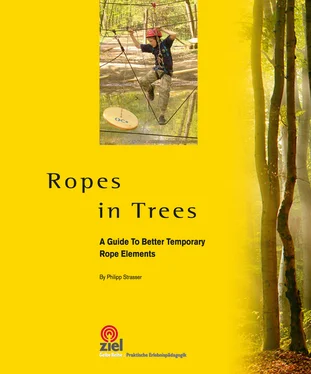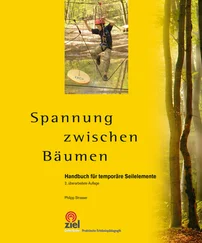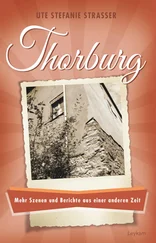3. Some fields are not completely covered by this book. The reader is assumed to have basic experience and familiarity with: urban forestry, ropes and materials, weather conditions, outdoor legal aspects, safety, rescue, knots, and team leadership.
4. This book covers the construction of temporary rope elements, their installation and use is secondary. Experience is taken for granted regarding installation areas, self-belay, belay of participants (ropes, spotting etc.), participant fitness etc.
5. The contents of this book were believed to be current at the time of publication. Operators must still inform themselves about possible modifications regarding installation, use, materials, legal aspects, norms and standards, etc. Please check the elements for suitability and function and report problems and concerns, as well as your experiences.
6. Well-trained and experienced rope element builders or users are able to detect material defects, wrong or misleading descriptions, to estimate potential risks and avoid problems and accidents.
7. The author is not liable for damages resulting from the installation and use of the elements that are described here.
8. Please only use elements if the physical and psychological well being of all participants is guaranteed.
9. Prior to setting up or using one of the described elements, please read all the comments and keep in mind that the book is set up chronologically.
Redundancy, Zero Accident, and Other Safety Issues
The elements described in this book were selected and prepared to the best of our knowledge and common practices. The elements are basically set up to provide redundancy.
Redundancy means that all safety relevant features are backed-up. This is not limited to equipment and design, but especially when human error can cause accidents. Crosschecking and clear communication between two responsible persons is crucial for redundancy – e.g. when checking belays or hooking a participant – even if this aspect is not covered explicitly in this book.
To check if an element is set up with redundancy it is important to ask: “What would happen if this carabiner, rope, or branch breaks?” If the primary safety system fails, then the participant must still be able to return safely to the ground. The secondary safety system is not meant to preserve the element, but rather to secure the participant. Therefore, it is not necessary to employ two identical safety systems. Due to the possibility of an accident caused by human error, redundancy is an essential component to the design.
Occasionally, redundancy is limited or its aim is reduced. Chapters of this book with limited redundancy are clearly labeled and explained.
Conclusion
Apply redundancy whenever necessary and feasible to limit the need for extra measures.
Redundancy and continuous safety are very important. This book does not show consecutive elements where the participants have to switch their equipment from one element to another: in the worst case they have to unhook themselves and face mortal danger.
Redundancy and continuous safety are important for the “zero accident” concept. This term, coined by Walter Siebert, does not mean that there will never be any accidents. It means that no accident or situation must remain unconsidered. 1If the equipment, design, or methodology creates a hazard or causes accidents, then the link between the accident and method must be investigated. If there is a link, then this method must be improved or abandoned. If a potential hazard risk is discovered, it is important to inform others. This can be done in special internet forums or other public social networks.
Various course designers and operators develop their own designs and construction approaches and have acquired knowledge through experience. This information is generally not shared as it gives them an advantage over competitors. However, due to the importance of safety, it is a matter of ethics to publish accidents or other incidents and provide new developments to the open market.
What Is a Temporary Rope Element or Temporary Rope Course?
The European construction standards (EN 15567, effective since 2008) define the terms and distinguish between static rope courses, mobile rope courses , and temporary rope elements .
Static rope courses are amusement rope courses or forest rope courses secured by self-belay, rail systems, semi-continuous systems (e.g. SBB system) or top rope. Static rope courses are also defined by the standard as seminar rope courses and installed seminar elements like “Pampers Pole” or “Giant Ladder” which are normally secured by top rope or N belay.
Mobile rope courses can be set up at different locations. Mobility means that the supporting structure is mobile, such as steel or wood scaffoldings where seminar or amusement courses can be installed. Various set up versions exist for seminar elements, such as “Pampers Pole” or “Giant Ladder.” Other concepts prefer quick mounting of amusement rope courses with several elements in a row at exhibitions or other events, such as the Burma Bridge or multiline traverses. These rope courses must meet the standard requirements.
Temporary rope courses or temporary rope elements are usually set up between trees or other non-mobile structures in a short period of time, for a limited period of time. They are completely dismounted after use. The trees and structures should be left in their original condition after use.
If the course is set up for less than seven days, it is not considered to be under the rope course standard. This means that they do not need to be released by a certifying authority like other rope courses and the sling points do not need to be checked by structural engineers or arborists. Regarding due diligence, every constructor must apply the most updated expertise regarding materials, sling points, and all other criteria, even if they do not have to be inspected by external officials. In case of an accident, the European construction standard may be referenced by accident investigators.
Temporary rope elements consist of the support system (poles, trees), the activity element, and a safety element (if the participants are lifted more than half a meter above ground level.) For elements less than half a meter from the ground, no safety element is required. The standard does not distinguish between high and low elements but refers to “adequate safety measures.”
“Low elements” are elements where the participants do not wear belays but are secured by other persons. “Low elements” might be covered under playground standards EN 1176 and EN 1177. The difference between a playground and a rope course is that a playground is a public domain and may be used without supervisors. Strictly speaking, an unsupervised and accessible temporary rope element must meet the playground standards. These standards define that there must be no risk of getting stuck or trapped. There must be no sharp edge, which means ratchet snaps must not be applied. EN 1177 defines the height of playing elements and the underlying dampening ground. It can be applied as a manual when securing rope elements.
“High elements” are elements that require participants to wear harnesses, and are secured from falling by several belay ropes.
Support System
The support system is the part of the construction to which the activity element and the safety elements are attached. For temporary rope elements, these are typically trees but can be other fixation points like rocks or buildings.
The support system must resist the same forces as the suspension points, such as heavy duty round slings and carabiners. Trees can be guyed for additional support.
Читать дальше












